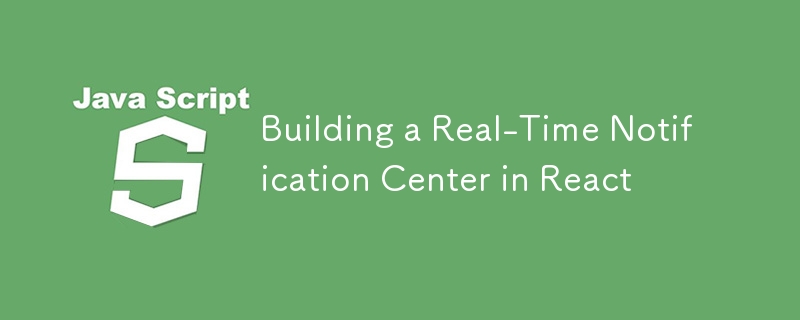

Benachrichtigungen halten Benutzer auf dem Laufenden und engagieren sie. Mit einem benutzerdefinierten React-Benachrichtigungscenter können Sie das Benutzererlebnis vollständig steuern und anpassen. Hier finden Sie eine kurze Anleitung zum Erstellen von Grund auf, die sowohl Frontend- als auch Backend-Komponenten für Echtzeit-Updates abdeckt.
Frontend
Backend
| Microservice | Functionality |
|---|---|
| Notification Service | Generates and stores notifications |
| Dispatch Service | Sends notifications to different channels |
| User Preferences Service | Manages user settings and preferences |
Example: Notification Service in Node.js/Express
const express = require('express');
const app = express();
let notifications = [];
app.post('/notify', (req, res) => {
const notification = {
id: notifications.length + 1,
type: req.body.type,
message: req.body.message,
userId: req.body.userId,
status: 'unread',
timestamp: new Date()
};
notifications.push(notification);
res.status(200).send(notification);
});
app.listen(3000, () => {
console.log('Notification Service running on port 3000');
});
Example: WebSocket Server with Socket.IO
const io = require('socket.io')(3001);
io.on('connection', (socket) => {
console.log('User connected:', socket.id);
socket.emit('notification', {
message: 'New notification!',
timestamp: new Date()
});
socket.on('disconnect', () => {
console.log('User disconnected:', socket.id);
});
});
Client-Side Integration in React
import React, { useEffect, useState } from 'react';
import io from 'socket.io-client';
const socket = io('http://localhost:3001');
function NotificationCenter() {
const [notifications, setNotifications] = useState([]);
useEffect(() => {
socket.on('notification', (notification) => {
setNotifications(prev => [...prev, notification]);
});
}, []);
return (
<div>
<h2>Notification Center</h2>
{notifications.map((notif, index) => (
<div key={index}>{notif.message} - {notif.timestamp}</div>
))}
</div>
);
}
export default NotificationCenter;
Example: Polling Implementation in React
import React, { useEffect, useState } from 'react';
function NotificationCenter() {
const [notifications, setNotifications] = useState([]);
useEffect(() => {
const interval = setInterval(() => {
fetch('/api/notifications')
.then(response => response.json())
.then(data => setNotifications(data));
}, 5000); // Poll every 5 seconds
return () => clearInterval(interval);
}, []);
return (
<div>
<h2>Notification Center</h2>
{notifications.map((notif, index) => (
<div key={index}>{notif.message}</div>
))}
</div>
);
}
export default NotificationCenter;
Example: Registering a Service Worker
if ('serviceWorker' in navigator) {
navigator.serviceWorker.register('/sw.js').then(registration => {
console.log('Service Worker registered:', registration.scope);
}).catch(error => {
console.error('Service Worker registration failed:', error);
});
}
Example: Displaying a Notification
if (Notification.permission === 'granted') {
new Notification('New message!', {
body: 'Click to view the message.',
icon: '/path/to/icon.png'
});
} else if (Notification.permission !== 'denied') {
Notification.requestPermission().then(permission => {
if (permission === 'granted') {
new Notification('New message!', {
body: 'Click to view the message.',
icon: '/path/to/icon.png'
});
}
});
}
Example: Sending Push Notifications with FCM in Node.js
const admin = require('firebase-admin');
const serviceAccount = require('./path/to/serviceAccountKey.json');
admin.initializeApp({
credential: admin.credential.cert(serviceAccount)
});
const message = {
notification: {
title: 'New Notification',
body: 'You have a new notification!'
},
token: 'device-token'
};
admin.messaging().send(message)
.then(response => console.log('Message sent:', response))
.catch(error => console.error('Error sending message:', error));
Example: Notification List Component
import React from 'react';
function NotificationList({ notifications }) {
return (
<div>
{notifications.map(notification => (
<div key={notification.id}>{notification.message}</div>
))}
</div>
);
}
export default NotificationList;
Example: Toast Notifications with react-toastify
import { toast } from 'react-toastify';
import 'react-toastify/dist/ReactToastify.css';
toast.configure();
function notify() {
toast('New notification!', { position: toast.POSITION.BOTTOM_RIGHT });
}
notify();
Example: Managing State with Redux
import { createSlice } from '@reduxjs/toolkit';
const notificationSlice = createSlice({
name: 'notifications',
initialState: [],
reducers: {
addNotification: (state, action) => {
state.push(action.payload);
},
markAsRead: (state, action) => {
const notification = state.find(n => n.id === action.payload);
if (notification) {
notification.read = true;
}
}
}
});
export const { addNotification, markAsRead } = notificationSlice.actions;
export default notificationSlice.reducer;
As a good dev, you should go on to build the notification system in react from scratch, but, if your boss needs it ASAP and you’ve got a vacation planned (or just really need a break), check out my tool. It simplifies everything and gives you ready-to-use components as your new notifications API, available in all popular SDK. So you can chill while we handle the infra! ??
Das obige ist der detaillierte Inhalt vonAufbau eines Echtzeit-Benachrichtigungscenters in React. Für weitere Informationen folgen Sie bitte anderen verwandten Artikeln auf der PHP chinesischen Website!
 Der Unterschied zwischen Windows-Ruhezustand und Ruhezustand
Der Unterschied zwischen Windows-Ruhezustand und Ruhezustand
 So richten Sie Douyin ein, um zu verhindern, dass jeder das Werk sieht
So richten Sie Douyin ein, um zu verhindern, dass jeder das Werk sieht
 Was ist Bitcoin? Ist es ein Betrug?
Was ist Bitcoin? Ist es ein Betrug?
 Die Rolle von Domain-Name-Servern
Die Rolle von Domain-Name-Servern
 Zusammenfassung der Java-Grundkenntnisse
Zusammenfassung der Java-Grundkenntnisse
 C#-Task-Nutzung
C#-Task-Nutzung
 Welche Versionen des Linux-Systems gibt es?
Welche Versionen des Linux-Systems gibt es?
 Verwendung zufälliger Funktionen in der C-Sprache
Verwendung zufälliger Funktionen in der C-Sprache




